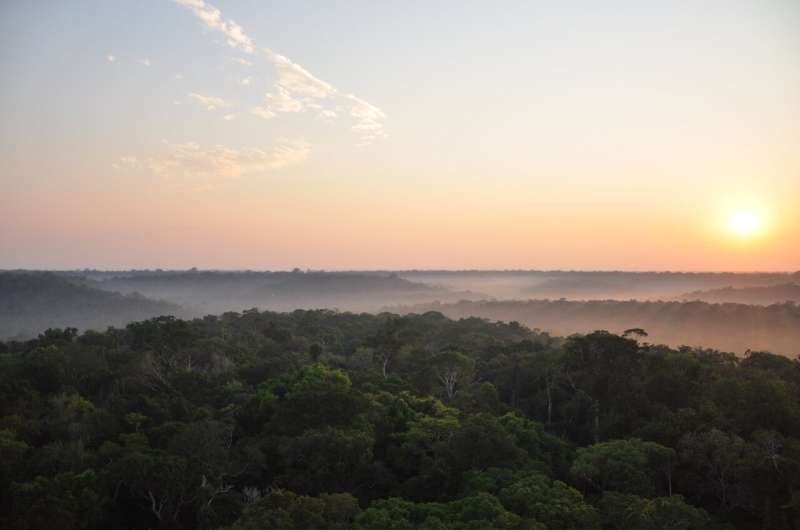Some Amazon rainforest regions more resistant to climate change than previously thought

Forests can help mitigate climate change, by taking in carbon dioxide during photosynthesis and storing it in their biomass (tree trunks, roots, etc.). In fact, forests currently take in around 25-30% of our human-generated carbon dioxide (CO2) emissions. Certain rainforest regions, such as the Amazon, store more carbon in their biomass than any other ecosystem or forest but when forests become water-stressed (not enough water in the soil, and/or air is extremely dry), forests will slow down or stop photosynthesis. This leaves more CO2 in the atmosphere, and can also lead to tree mortality.
The current Earth system models used for climate predictions show that the Amazon rainforest is very sensitive to water stress. Since the air in the future is predicted to get warmer and drier with climate change, translating to increased water stress, this could have large implications not just for the forest's survival, but also for its storage of CO2. If the forest is not able to survive in its current capacity, climate change could greatly accelerate.
Columbia Engineering researchers decided to investigate whether this was true, whether these forests are really as sensitive to water stress as what the models have been showing. In a study published today in Science Advances, they report their discovery that these models have been largely over-estimating water stress in tropical forests.
The team found that, while models show that increases in air dryness greatly diminish photosynthesis rates in certain regions of the Amazon rainforest, the observational data results show the opposite: in certain very wet regions, the forests instead even increase photosynthesis rates in response to drier air.
"To our knowledge, this is the first basin-wide study to demonstrate how—contrary to what models are showing—photosynthesis is in fact increasing in some of the very wet regions of the Amazon rainforest during limited water stress," said Pierre Gentine, associate professor of earth and environmental engineering and of earth and environmental sciences and affiliated with the Earth Institute. "This increase is linked to atmospheric dryness in addition to radiation and can be largely explained by changes in the photosynthetic capacity of the canopy. As the trees become stressed, they generate more efficient leaves that can more than compensate for water stress."
Gentine and his former Ph.D. student Julia Green used data from the Intergovernmental Panel on Climate Change's Coupled Model Intercomparison Project 5 (CMIP5) models and combined them with machine learning techniques to determine what the modeled sensitivity of photosynthesis in the tropical regions of the Americas was to both soil moisture and air dryness. They then performed a similar analysis, this time using observational remote sensing data from satellites in place of the model data, to see how the observational sensitivity compared. To relate their results to smaller-scale processes that could explain them, the team then used flux tower data to understand their results at the canopy and leaf level.
Earlier studies have shown that there are increases in greenness in the Amazon basin at the end of the dry season, when both the soil and air is drier, and some have linked this to increases in photosynthesis. "But before our study, it was still unclear whether these results translated to an effect over a larger region, and they had never been connected to air dryness in addition to light," Green, who is now a postdoctoral research associate at Le Laboratoire des Sciences du Climat et de l'Environnement in France, explained. "Our results mean that the current models are overestimating carbon losses in the Amazon rainforest due to climate change. Thus, in this particular region, these forests may in fact be able to sustain photosynthesis rates, or even increase it, with some warming and drying in the future."
Gentine and Green note, however, that this sensitivity was determined using only existing data and, if dryness levels were to increase to levels that are not currently being observed, this could in fact change. Indeed, the researchers found a tipping point for the most severe dryness stress episodes where the forest could not maintain its level of photosynthesis. So, say Gentine and Green, "our findings are certainly not an excuse to not reduce our carbon emissions."
Gentine and Green are continuing to look at themes related to vegetation water stress in the tropics. Green is currently focusing on developing a water stress indicator using remote sensing data (a dataset that can be used to identify when a forest is under stressful conditions), quantifying the effects of water stress on plant carbon uptake, and relating them to ecosystem traits.
"So much of the scientific research coming out these days is that with climate change, our current ecosystems might not be able to survive, potentially leading to the acceleration of global warming due to feedbacks," Green added. "It was nice to see that maybe some of our estimates of approaching mortality in the Amazon rainforest may not be quite as dire as we previously thought."
The study is titled "Amazon rainforest photosynthesis increases in response to atmospheric dryness."
More information: J.K. Green el al., "Amazon rainforest photosynthesis increases in response to atmospheric dryness," Science Advances (2020). advances.sciencemag.org/lookup … .1126/sciadv.abb7232
Journal information: Science Advances




















